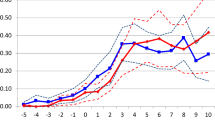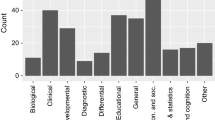Abstract
Recently, questions about gender gaps in science have extended to academic technology transfer. Using systematic data on US medical school faculty, we capture both behavior and performance, examining the hypothesis that women are less likely than men to commercialize their research findings. We pooled faculty invention data from ten departments in three Academic Health Centers from 1991 to 1998—a period when patenting had become prevalent and other researchers note that a gender gap was pronounced. Rather than focusing on patenting, we capture the first step in the commercialization process, as well as the subsequent successful licensing of faculty inventions to a company. We find no significant gender differences in the likelihood of reporting inventions or successfully commercializing them. We do find differences in the number of inventions reported, however, with women disclosing fewer inventions than their male counterparts. Our results demonstrate that gender effects are highly conditioned by employment context and resources. We attribute differences in our findings with regards to gender to the use of outcome measures that capture both behavior and performance, and the inclusion of a more extensive set of control variables.
Similar content being viewed by others
Notes
The NIH is a US government research agency made up of 27 different institutes and centers, including the NLM.
References
Azoulay, P., Michigan, R., & Sampat, B. N. (2007). The anatomy of medical school patenting. New England Journal of Medicine, 357, 2049–2056.
Azoulay, P., Stellman, A., & Zivin, J. G. (2006). PublicationHarvester: An open-source software tool for science policy research. Research Policy, 35, 970–974.
Bercovitz, J., & Feldman, M. (2008). Academic entrepreneurs: Organizational change at the individual level. Organization Science, 19(1), 69–89.
Bird, S. R. (2011). Unsettling universities’ incongruous, gendered bureaucratic structures: A case-study approach. Gender, Work and Organization, 18(2), 202–239.
Casper, S., & Murray, F. (2005). Careers and clusters: Analyzing the career network dynamics of biotechnology clusters. Journal of Engineering and Technology Management, 22, 51–74.
Colyvas, J. A. (2011). Performance metrics as formal structures: How do they operate and how do they influence? American Journal of Education. Forthcoming.
Colyvas, J. A., & Powell, W. W. (2009). Measures, metrics, and myopia: The challenges and ramifications of sustaining academic entrepreneurship. Advances in the Study of Entrepreneurship, Innovation, and Economic Growth, 19, 276–298.
Dasgupta, P., & David, P. (1994). Toward a new economics of science. Research Policy, 23(5), 487–521.
Ding, W., Murray, F., & Stuart, T. (2006). Gender differences in patenting in the academic life sciences. Science, 313(5787), 577–716.
Fox, M. F. (2001). Women, science, and academia: Graduate education and careers. Gender & Society, 15, 654–666.
Fox, M. F. (2010). Women and men faculty in academic science and engineering: Social and organizational indicators and implications. American Behavioral Scientist, 53, 997–1012.
Fox, M. F., & Colatrella, C. (2006). Participation, performance, and advancement of women in academic science and engineering: What is at issue and why. Journal of Technology Transfer, 31, 377–386.
Grandi, A., & Grimaldi, R. (2005). Academics’ organizational characteristics and the generation of successful business ideas. Journal of Business Venturing, 20(6), 821–845.
Haeussler, C., & Colyvas, J. A. (2011). Breaking the ivory tower: Academic entrepreneurship in the life sciences in UK and Germany. Research Policy, 40(4), 41–54.
Heckman, J. (1976). The common structure of statistical models of truncation, sample selection and limited dependent variables and a simple estimator for such models. Annals of Economic and Social Measurement, 5, 475–492.
Jaffe, A. B., & Lerner, J. (2004). Innovation and its discontents. Princeton, NJ: Princeton University Press.
Jaffe, A. B., & Trajtenberg, M. (2002). Patents, citations, and innovations. Boston, MA: MIT Press.
Kantor, R. M. (1977, 1993). Men and women of the corporation. New York: Basic Books.
Link, A. N., Siegel, S. S., & Bozeman, B. (2007). An empirical analysis of the propensity of academics to engage in informal university technology transfer. Industrial and Corporate Change, 16(4), 641–655.
Magrane, D., Clark, V., & Yamagata, H. (2004). Women in US academic medicine statistics and medical school benchmarking 2003–2004. Chicago, IL: AAMC.
Mowery, D., Nelson, R., Sampat, B. N., & Ziedonis, A. (2004). Ivory tower and industrial innovation. Stanford, CA: Stanford University Press.
Murray, F., & Graham, L. (2007). Buying science and selling science: Gender differences in the market for commercial science. Industrial and Corporate Change, 16(4), 657–689.
Nelson, A. J. (2009). Measuring knowledge spillovers: What patents, licenses and publications reveal about innovation diffusion. Research Policy, 38(6), 994–1005.
Owen-Smith, J. (2003). From separate systems to a hybrid order: Accumulative advantage across public and private science at research one universities. Research Policy, 32(6), 1081–1104.
Packer, K., & Webster, A. (1996). Patenting culture in science: Reinventing the wheel of credibility. Science, Technology and Human Values, 21(4), 427–453.
Papke, L. E., & Wooldridge, J. (1996). Econometric methods for fractional response variables with an application to 401(k) plan participation rates. Journal of Applied Econometrics, 11, 619–632.
Powell, W. W., Owen-Smith, J., & Colyvas, J. A. (2007). Innovation and emulation: Lessons from American universities in selling private rights to public knowledge. Minerva, 45, 121–142.
Rhoten, D., & Powell, W. W. (2007). The frontiers of intellectual property: Expanded protection vs. new models of open science. Annual Review of Law and Social Science, 3, 345–373.
Ridgeway, C. L. (2009). Framed before we know it: How gender shapes social relations. Gender and Society, 23, 145–160.
Rosenberg, N., & Nelson, R. (1994). American universities and technical advance in industry. Research Policy, 23(3), 323–348.
Sampat, B. (2006). Patenting and US academic research in the twentieth century: The world before and after Bayh Dole. Research Policy, 35(6), 772–789.
Shane, S. (2000). Prior knowledge and the discovery of entrepreneurial opportunities. Organizational Science, 11(4), 448–469.
Smith-Doerr, L. (2004). Women’s work: Gender equality versus hierarchy in the life sciences. Boulder, CO: Lynne Rienner Publishers.
Stephan, P. E., Gurmu, A., Sumell, A. J., & Black, G. (2007). Who’s patenting in the university? Evidence from the survey of doctorate recipients. Economics of Innovation on New Technology, 16(2), 71–99.
Stephan, P., & Levin, S. G. (1992). Striking the mother lode in science: The importance of age, place and time. New York: Oxford University Press.
Stuart, T., & Ding, W. W. (2006). When do scientists become entrepreneurs? The social structural antecedents of commercial activity in the academic life sciences. American Journal of Sociology, 112, 97–144.
Thursby, J. G., & Thursby, M. C. (2005). Gender patterns of research and licensing activity of science and engineering faculty. Journal of Technology Transfer, 30, 343–353.
Vallas, S. P., & Kleinman, D. L. (2008). Contradiction, convergence, and the knowledge economy: The co-evolution of academic and commercial biotechnology. Socio-Economic Review, 6(2), 283–311.
Vallas, S. P., Kleinman, D. P., & Biscotti, D. (Forthcoming). The making of the knowledge economy: State intervention and the commercialization of the life sciences. In Fred Block (Ed.), Half empty and half full: US government innovation policies, 1969–2008.
Whittington, K. B. (2009). Patterns of male and female dissemination in public and private science. In R. B. Freeman & D. F. Goroff (Eds.), The new market for scientists and engineers: The science and engineering workforce in the era of globalization. Chicago, IL: University of Chicago Press.
Whittington, K. B. (2011). Gender, motherhood, and scientific work across employment sectors: Commercial patenting in academia and industry. Work and Occupations, 38(3), 417–456.
Whittington, K. B., & Smith-Doerr, L. (2005). Women and commercial science: Women’s patenting in the life sciences. Journal of Technology Transfer, 30, 355–370.
Whittington, K. B., & Smith-Doerr, L. (2008). Women inventors in context: Disparities in patenting across academia and industry. Gender & Society, 22(2), 194–218.
Xie, Y., & Shauman, K. A. (2003). Women in science. Boston, MA: Harvard University Press.
Acknowledgments
This work was supported by Northwestern University Research Grants Committee, the National Science Foundation (SES0849036), and the Andrew W. Mellon Foundation.
Author information
Authors and Affiliations
Corresponding author
Rights and permissions
About this article
Cite this article
Colyvas, J.A., Snellman, K., Bercovitz, J. et al. Disentangling effort and performance: a renewed look at gender differences in commercializing medical school research. J Technol Transf 37, 478–489 (2012). https://doi.org/10.1007/s10961-011-9235-6
Published:
Issue Date:
DOI: https://doi.org/10.1007/s10961-011-9235-6
Keywords
- University technology transfer
- Academic entrepreneurship, university performance metrics
- Gender
- Biomedicine
- Life sciences
- Biomedical innovation




